The Beretta ARX 100: A Great Idea That Never Caught On
When it made its debut at the 2013 SHOT Show, the Beretta ARX 100 seemed like a radical new rifle destined to capture sales from the FNH SCAR, Bushmaster ACR and the various AR-15 models from different manufacturers. It had eye-catching aesthetics, a quick-change barrel with several promised caliber conversions and seemingly every feature one could want in a tactical rifle. This included ambidextrous controls, side-swapping ejection at the touch of a button and gas-piston operation. It even used AR-15 magazines.
Beretta also claimed the rifle’s polymer construction required minimal lubrication which was a big selling point at a time where desert wars were raging and existing rifles reportedly were prone to malfunction with all the airborne sand and grit. The ARX 100 even captured the 2014 Golden Bullseye Award for Rifle of the Year from NRA’s Shooting Illustrated magazine. But despite these winning attributes, this intriguing rifle saw little success in the U.S. market.
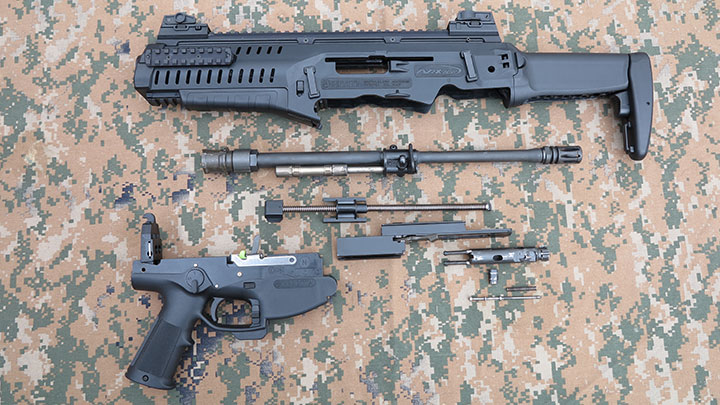
- Activate Your Own Stem Cells & Reverse The Aging Process - Choose "Select & Save" OR Join, Brand Partner & Select Silver To Get Wholesale Prices
- Get your Vitamin B17 & Get 10% Off With Promo Code TIM
- How To Protect Yourself From 5G, EMF & RF Radiation
- Protect Your Income & Retirement Assets With Gold & Silver
- Grab This Bucket Of Heirloom Seeds & Get Free Shipping With Promo Code TIM
- Here’s A Way You Can Stockpile Food For The Future
- Stockpile Your Ammo & Save $15 On Your First Order
- Preparing Also Means Detoxifying – Here’s One Simple Way To Detoxify
Though the rifle is still shown on Beretta’s website, production effectively ceased in 2019 after a five-year run. The ARX 100’s unfortunately short life span would be an interesting case study for a business school marketing class. At a minimum, it remains a cautionary tale of how an innovative firearm from a major gun maker with a trusted reputation doesn’t guarantee success. But before we explore the reasons why the ARX 100 never took off, the background and specifics of what this rifle is all about are important.
Background
The ARX 100 is a civilian offshoot of the ARX 160 rifle designed and made by Beretta in Italy and first fielded in 2008 by the Italian military. Produced at Beretta’s Accokeek, Md., plant using only American made parts, the ARX 100 debuted at the Jan., 2013 SHOT Show, but widespread distribution was delayed until mid 2014 after generating significant market interest. Beretta also sold .22 LR pistol and rifle versions made in Germany by Umarex to Beretta’s specs and curiously branded as the ARX 160, the same designation as the military version.
Construction
The ARX 100 is constructed largely of polymer including the upper and lower receivers and weighs 6.8 lbs. compared to FNH’s civilian version of the M4 that weighs 6.6 lbs. It has a 16” barrel with a 1:7” twist. Its overall length is just under 36” with the stock fully extended, and only 26.5” with the stock folded making it a compact rifle that is quickly deployable.
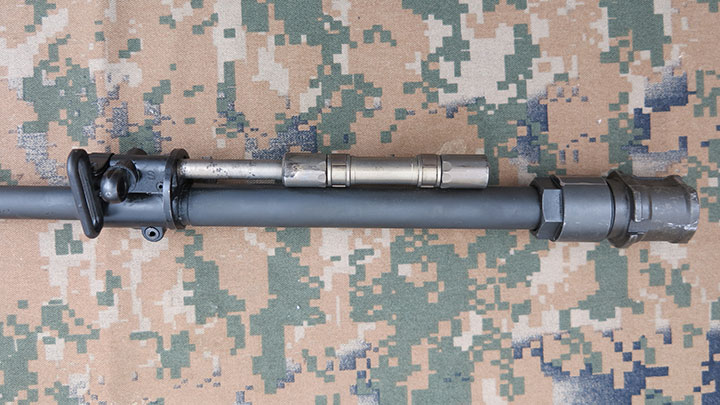
The serial-numbered upper receiver houses the bolt carrier assembly and quick-detach barrel. It joins with the magazine well and grip frame that form the lower receiver, which holds the fire control parts made of polymer and steel. Disassembly involves no tools or push pins to lose in the field. To start the process, fold the stock to access a retaining plate in the rear of the receiver. Depress this plate while rotating the safety lever upward past the safe position, then swing the lower receiver downward and remove it from the upper.
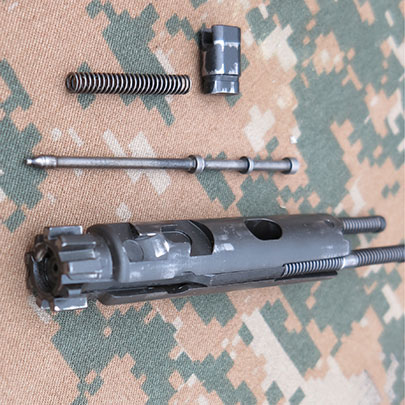
The ARX 100 uses a gas-piston cylinder to cycle the action that moves about 2” rearward to engage the bolt carrier. The bolt has seven lugs that rotate to lock with the barrel extension but is otherwise uniquely designed and distinct from the standard AR-15 bolt.
Innovative Features
The ARX 100’s anomalous appearance hints at some inventive and sometimes unique features. Most of them are worthwhile and not merely enticements to the gadget-driven and sometimes gimmick-driven gun buyer. On top of my list of innovations is the quick-change barrel, which allows for fast caliber conversion. Removing the barrel takes less than one minute.
To start, retract the bolt about half way rearward and pull the charging handle outward to prevent it from moving forward. Then pull down on two tabs located on each side of the fore-end, as if field-stripping a Glock, and pull the barrel assembly out of the receiver. Beretta sold a small number of .300 BLK barrels, which is an easy conversion because .300 BLK uses the same bolt and magazine as the 5.56×45 mm NATO. Beretta also offered a 10.5” 5.56×45 mm NATO barrel for those who wanted to convert the platform to a short barrel rifle.
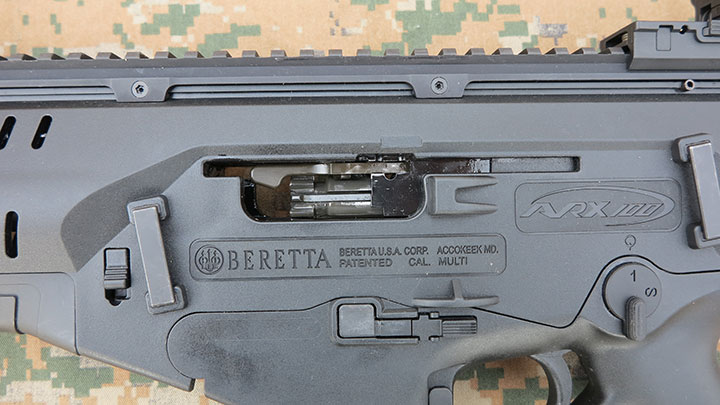
Second and third on my list are the switch-side charging handle and selective side ejection. The reciprocating charging handle pivots to either side. This accommodates a shooter’s preference as to which side he wants the reciprocating handle to move, and which hand he prefers to use to clear stoppages by grasping the handle. The ejection side can be swapped by depressing a recessed button at the rear of the receiver using the tip of a bullet without disassembly or changing parts.
Last on my list are the easily accessible and completely ambidextrous safety, magazine release and bolt catch. The latter part is located in three places, which include bilaterally on the receiver and at its centerline just ahead of the trigger guard. On an interesting note, the bolt catch also serves as a magazine release when it is pushed upward, but that method is far slower than using the side mounted release.
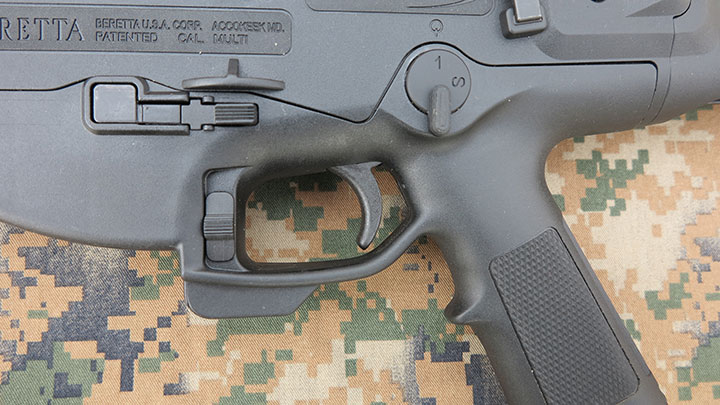
There are also more ordinary, but nonetheless attractive features. The four-position adjustable stock is sturdy and the rifle can operate with it folded or removed completely. The A2-style pistol grip has a hinged compartment for stowing batteries. The gas system has two settings that can be changed using a cartridge tip; one for normal and the other if cycling is sluggish.
Six strap sling mounts work well with the included Condor two point quick adjust sling. The magazine is made of steel which is more durable than aluminum. Finally, the fore-end has a 3.75” Picatinny rail on both sides and a small one on the front portion of its bottom that merges with a mount for the GLX 160 40 mm grenade launcher that is hidden under a removable cover. The grenade launcher mount can be converted to a Picatinny rail using a part from Beretta.
Why It Didn’t Succeed
Several reasons caused the early demise of this promising rifle. Perhaps most fateful was its rocky launch with many months of delay between its unveiling and widespread distribution. By the time dealers got product, the black-rifle craze was on the wane. An MSRP of $1,950 with a dealer price of $1,490 also hurt sales beyond the typical early adopters, novelty seekers and collectors who are inclined to embrace unconventional aesthetics that may be a stretch for consumers in the mainline of the market. The rifle’s abundantly plastic construction also made it seem overpriced to some.
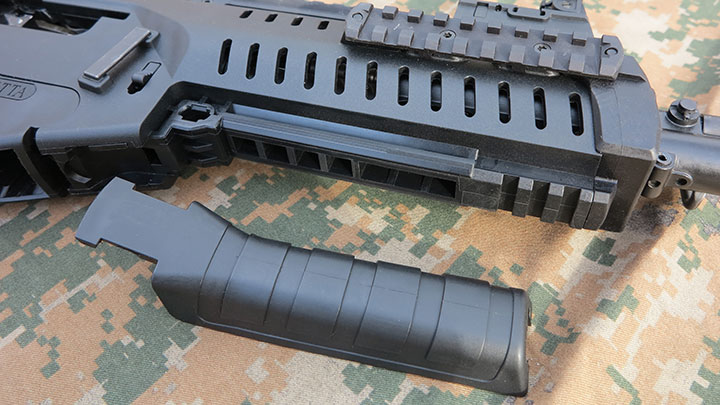
The abandonment of the anticipated caliber conversion kits in .300 BLK, 762×39 mm, 5.45×39 mm and 6.8 SPC likely diminished its appeal as did the $575 price at which Beretta sold 10.25” 5.56×45 mm NATO barrels for those who intended to SBR their ARX. Finally, the rifle’s peculiarities were likely contributory. Its lack of QD sling sockets in favor of strap sling mounts, odd looking and seemingly fragile plastic sights and a stock with a distinct “underbelly” that was as attractive to some Americans as a hunting rifle with a Schnable fore-end and hogback comb. These are interesting but foreign features, and not to the liking of many potential buyers.
Personally, I had three related concerns with the polymer receiver, being the longevity of the receiver rails with the bolt carrier riding on them with every shot, how its rigidity would affect accuracy and whether the rifle’s zero would substantially shift as it heated up from firing.
Accuracy
The ARX 100 is not intended to be anything but a military rifle and its design limits accuracy for at least four reasons. The quick-change barrel interface is inherently not as rigid as a fixed mount, the polymer receiver flexes during firing, the pencil thin barrel after the gas block has more harmonic whip than thicker barrels and the rife uses gas piston operation.
As such, I expected it to shoot 3-m.o.a. groups on average but was pleasantly surprised by SIG Sauer’s 55-grn. FMJ load that gave a best/average five-shot group of .90” to 1.67” fired from a Caldwell Precision Turret rest at 100 yds. using a Leopold Mark IV 8.5-25×50 mm scope. The other two loads were far behind, however (see table). One thing that was apparent was a tendency, mostly with the other loads, to give an occasional wild group widening shot that I could not attribute to shooter error. Even discounting those wild cards, SIG Sauer’s 55-grn. load unquestionably performed the best.
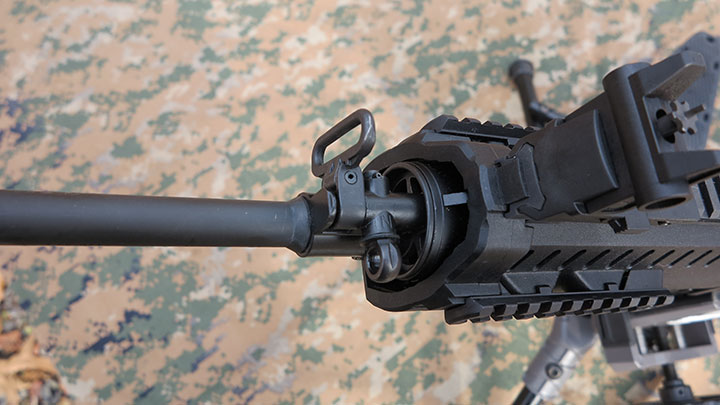
Quick change barrel rifles often show a change in zero point when the barrel is removed and replaced and the ARX 100 was no exception. After removing and replacing the barrel, I cycled the action a dozen times in an attempt to seat but still found the first two shots were errant and the remaining three came within .5” of the original zero point at 100 yds. Unfortunately, these were the last of my SIG 55-grn. ammo, so the question remains as to whether additional shots bring the rifle completely back to zero.
Should Beretta Relaunch the ARX 100?
Absolutely! I’d love to see it at a lower price with a few improvements and positioned as a defensive firearm.
As with all things manmade, perfection is elusive even if we could all agree on what that means when it comes to a defensive semi-automatic rifle. With that said, here’s how the ARX 100 can be modified into a big seller now that unfortunate market timing is no longer a factor. It still won’t be perfect, but these changes are at the margins and are realistic to expect. Besides, they should extinguish the complaints of all but the most implacable internet “influencers.”
Trigger
The days when buyers excused heavy triggers as “military triggers” are long gone. With the lines that separate competition triggers from tactical triggers converging, Beretta needs to make the ARX 100’s trigger which has a 10.5 lb. pull weight at least as crisp and the same weight as that on a standard AR-15, which is about 5.5 lbs.
Comb Height and LOP
The comb is too low to comfortably align your eyes with not only with the back-up iron sights, but with any magnified optic and most red dot sights with the exception of a very low mount micro red dot. A riser on the comb would be ideal if it retracts easily so it does not interfere with ejected brass if the rifle is fired with the stock folded. The stock is also noticeably short with a maximum length-of-pull at 12.87” compared to 13.5” for an AR-15 with its collapsible stock extended. An extra 1.25” would be ideal.
Sling Mounts
Though the strap sling mounts work well with two-point slings, the rifle will sell better if it had QD sling sockets which are now the standard for tactical rifles and work with any sling.
More Prominent Controls
The safety and bolt catch would be more ergonomic if wider.
Sights
The ARX 100 uses plastic, spring-loaded, flip-up sights. The front is a protected post that adjusts for elevation like on an AR-15 and for windage with a slotted screwdriver. The rear is a diopter disk with 5 settings for 100, 200, 300, 400 and 600 meters presumably using the M855 5.56×45 mm NATO load.
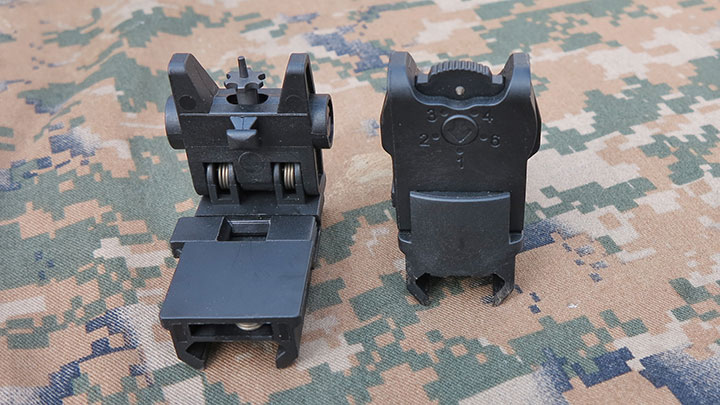
Lacking is a large aperture for closer and dim light engagements along with click adjustments on the front windage screw with an explanation of how many m.o.a. each click is worth to make sighting in easier. Yes they are back up sights, but anyone who takes the concept of emergency sights seriously will replace these in an instant and Beretta’s ARX 160A3 rifle seems to have done just that with its iron sights.
Four Position Gas Regulator
Adding both a reduced gas setting and an off position for manual operation would be valuable for those who want to shoot this rifle suppressed and either adjust gas input to mitigate back pressure or gauge how quiet the suppressed rifle is without cycling the action.
| Smallest | Largest | Average |
| Federal AE 223 55grn FMJ | 2.15” | 4.20” | 3.14” |
| Sig Sauer 55grn FMJ | .90” | 2.30” | 1.56” |
| Sig Sauer 77grn JHP Match | 1.97” | 3.13” | 2.66” |
Size in inches of five, 5 shot groups shot at 100 yds. from a Caldwell Precision Turret rest and measured center to center.
Mean Velocity
| Federal AE 223 55grn FMJ | 2,740 f.p.s. |
| Sig Sauer 55grn FMJ | 2,790 f.p.s. |
| Sig Sauer 77grn JHP Match | 2,520 f.p.s. |
Velocity measured 15’ from the muzzle with an Oehler 35 chronograph at 56 degrees F.
Specifications
| Caliber: | 5.56×45 mm NATO |
| Barrel: | 16” |
| OA Length: | 26.5” -35.5” |
| Weight: | 6.8 lbs. unloaded |
| Sights: | Adjustable aperture |
| Stocks: | Polymer, collapsible and folding |
| Action: | Semi auto |
| Capacity: | 30+1 |
| MSRP: | N/A
|
Article by ANDY MASSIMILIAN














